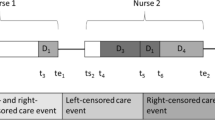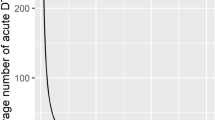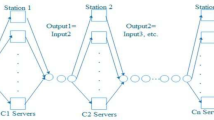Abstract
This paper uses a queuing model to evaluate completion times in Accident and Emergency (A&E) departments in the light of the Government target of completing and discharging 98% of patients inside 4 h. It illustrates how flows though an A&E can be accurately represented as a queuing process, how outputs can be used to visualise and interpret the 4-h Government target in a simple way and how the model can be used to assess the practical achievability of A&E targets in the future. The paper finds that A&E targets have resulted in significant improvements in completion times and thus deal with a major source of complaint by users of the National Health Service in the UK. It suggests that whilst some of this improvement is attributable to better management, some is also due to the way some patients in A&E are designated and therefore counted through the system. It finds for example that the current target would not have been possible without some form of patient re-designation or re-labelling taking place. Further it finds that the current target is so demanding that the integrity of reported performance is open to question. Related incentives and demand management issues resulting from the target are also briefly discussed.
Similar content being viewed by others
References
Aharonson-Daniel L, Fung H, Hedley AJ (1996) Time studies in A&E departments—a useful tool for management. J Manage Med 10(3):15–22
Barlow GL (2002) Auditing hospital queuing. Manag Audit J 17(7):397–403
Brailsford SC, Lattimer VA, Tamaras P, Turnbull JC (2004) Emergency and on demand health care: modelling a large and complex system. J Oper Res Soc 55:34–42
Bronson R, Naadimuthu G (1997) Operations Research, 2nd edition, MacGraw-Hill, New York London
Bučar T, Nagode M, Fajdiga M (2004) Reliability approximation using finite Weibull mixture distributions. Reliab Eng Syst Saf 84:241–251
Coates TJ, Michalis S (2001) Mathematical modelling of patient flow through an accident and emergency department. Emerg Med J 18:190–192
Fletcher A, Halsall D, Huxham S, Worthington D (2006) The DH accident and emergency department model—a national generic model used locally. Lancaster University Management School Working Paper 2006/042. Lancaster, UK
Gorunescu F, McClean SI, Millard PH (2002) A queuing model for bed occupancy management and planning of hospital. J Oper Res Soc 53:19–24
Jun J, Jacobson S, Swisher J (1999) Applications of discrete-event simulation in health care clinics: a survey. J Oper Res Soc 50:109–123
Lane DC, Monefeldt C, Rosenhead JV (2000) Looking in the wrong place for health care improvements: a system dynamics study of an accident and emergency department. J Oper Res Soc 51(5):518–531(14)
Mayhew L (1987) Resource inputs and performance outputs in social security. J Oper Res Soc 38(10):913–928
Mayhew L, Carney Jones E (2003) Evaluating a New Approach for Improving Care in an Accident and Emergency Department. Cass Business School (60 pp)
Mayhew L, Smith D (2006) Using Queuing Theory to Analyse Completion Times in Accident and Emergency Departments in the Light of the Government 4-hour Target. Actuarial Research Paper 177, City University
Ross S (1997) Introduction to Probability Models, 6th Edition. Academic Press, San Diego US
Saaty TL, Alexander JM (1981) Thinking with Models. Pergamon Press, Oxford
Siddharthan K, Jones WJ, Johnson JA (1996) A priority queuing model to reduce waiting times in emergency care. Int J Health Care Qual 9(5):10–16
Taha H (ed) (2007) Operations research—an introduction. MacMillan, London, New York
Van Vuuren M, Adan I, Resing-Sassen S (2005) Perfomance analysis of multi-server tandem queues with finite buffers and blocking. OR Spectrum 27:315–338
Author information
Authors and Affiliations
Corresponding author
Rights and permissions
About this article
Cite this article
Mayhew, L., Smith, D. Using queuing theory to analyse the Government’s 4-h completion time target in Accident and Emergency departments. Health Care Manage Sci 11, 11–21 (2008). https://doi.org/10.1007/s10729-007-9033-8
Received:
Accepted:
Published:
Issue Date:
DOI: https://doi.org/10.1007/s10729-007-9033-8




